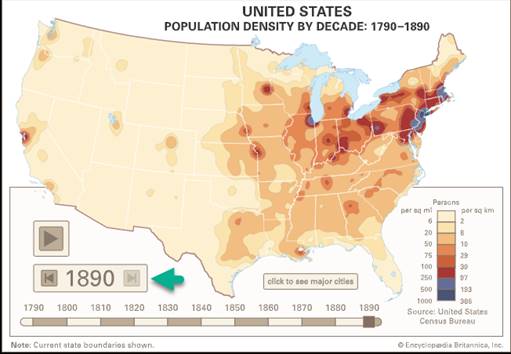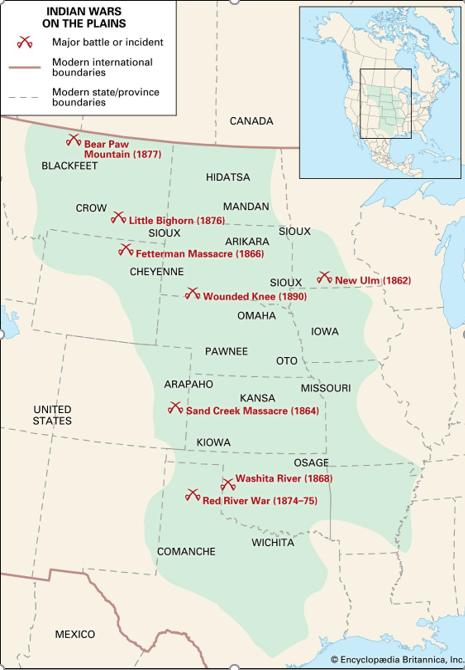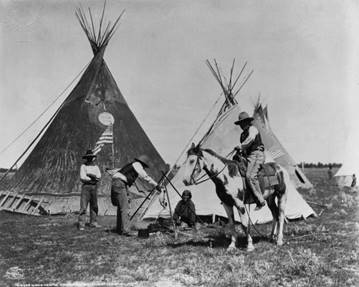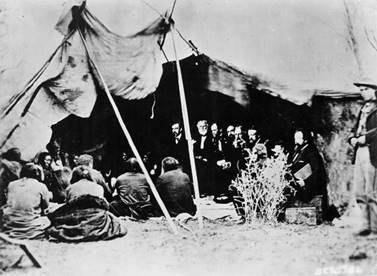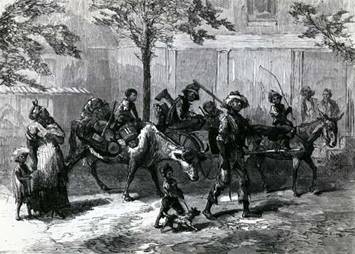Disenfranchised
American Indian
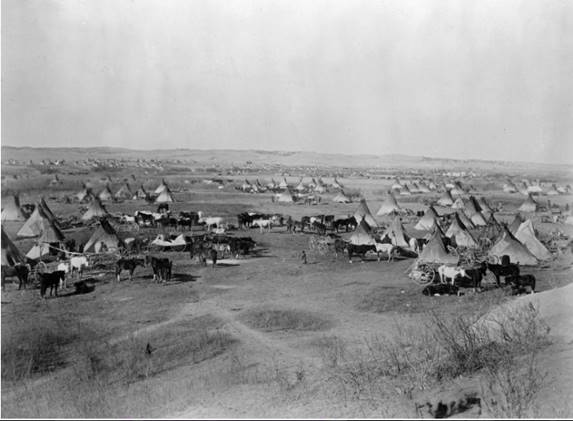
Figure 1 Lakota Camp near Pine Ridge Reservation,
southwestern South Dakota, 1891
|
Content Statement #11 |
|
Continued settlement by Americans in
the West intensified conflict with American Indians and reinforced
the policy of the reservation system. |
|
Content Elaboration |
|
Industrialization led to increased demand for natural resources and
encouraged westward migration by Americans. As Americans moved west, conflicts
often occurred as Americans came into contact with American Indians.
Consequences of these conflicts included: ü
the Plains
Wars; ü
the Battle of
Little Bighorn; ü
the Wounded
Knee Massacre; and ü
resistance to
assimilation (e.g., Ghost Dance). The demand for resources and land in
the West changed the life of the American Indians, who continued to be
displaced from their ancestral lands through a series of treaties and government actions
that included: ü
Homestead Acts;
ü
Dawes Act; ü
reservation system;
ü
Indian
residential schools; and ü
Americanization
and assimilation |
|
Section A |
|
|
Westward Migration
Figure 2 Westward
expansion of 1890 |
|
|
1)
|
The 1800s were a time of struggle for Native
Americans. |
|
2)
|
As the United States
expanded westward, settlers and the U.S. government treated the Indians as an
obstacle to be overcome. |
|
3)
|
Native Americans resisted the
invasion of their lands in the courts and in battle. |
|
4)
|
Violent clashes over land
erupted across the United States throughout the 1800s. |
|
5)
|
Many confrontations between Indian
tribes and government forces took place on the Great Plains. |
Let’s Practice
Click below to watch a video and complete a quiz on Westward
Expansion.
|
Section B |
||
|
Conflicts
Figure 3 Indian
Wars on the Plains |
||
|
6)
|
In the second half of the 1800s, as
American settlers intruded on tribal lands, American Indians and United
States forces fought a number of battles for control of the Great Plains. |
|
|
7)
|
Some events of this
period, however, are more accurately called massacres rather than battles. |
|
|
8)
|
In the Sand Creek Massacre of 1864,
members of the Colorado militia attacked a Cheyenne village and killed
between 150 and 500 people. |
|
|
9)
|
In the Fetterman Massacre
of 1866, Sioux warriors killed an entire unit of 80 U.S. soldiers. |
|
|
10)
|
The conquest of the Indians was
completed in 1890 at Wounded Knee in South Dakota, where U.S. troops
massacred more than 200 Sioux men, women, and children. |
|
|
11)
|
The United States
government adopted a policy of assimilation in which was an attempt to destroy
traditional Indian cultural identities. |
|
|
12)
|
The term "reservation" comes
from the belief that tribes were independent, sovereign nations at the time
the U.S. Constitution was ratified.
Figure
4 Indian
reservation/ Montana/ photo 1906. |
|
|
13)
|
Toward the end of the
nineteenth century, reports about the poor quality of life on
reservations led the federal government to change to a new policy
based on forced assimilation instead of concentration and isolation onto
reservations. |
|
Let’s Practice
Click below to watch a video and complete a quiz on the
Wounded
Knee Massacre.
|
Section C |
||
|
Treaties and Government Actions
Figure
5 General William T. Sherman negotiates
the Fort Laramie Treaty of 1868 with the
Sioux and Arapaho peoples |
||
|
14)
|
Homestead Act of 1862 Ø
a significant
U.S. law that promoted the settlement and development of the American West. Ø
It was notable
for the opportunity it gave African Americans to own land. Ø
The U.S.
government passed the Homestead Act to encourage western migration.
Figure
6 African
American families travel to Kansas as part of the exodus from the South to
the West in the 1870s. The Homestead Act of 1862 made owning land in the West
an option for everyone. |
|
|
15)
|
Dawes Act Ø The law was meant to handle the issue of Native
American tribes in the United States. Ø Native Americans have lived as separate nations Ø Many conflicts between American Indians and settlers o “reservations” had not resolved the issue Ø The Dawes Act was designed to break up the
long-established tribal organization of Native American society o The land was given to American to settle on American
Indian land o The land was owned by the United States government
for 25 years Ø Keys o Sought to protect American Indians given them land o Most land unsuitable for farming o Suitable land was given to white men o Forced “Americanization” on Indians o Dawes Act was a legislature failure |
|
Let’s Practice
Click below to play a matching game
on the American Indian.
